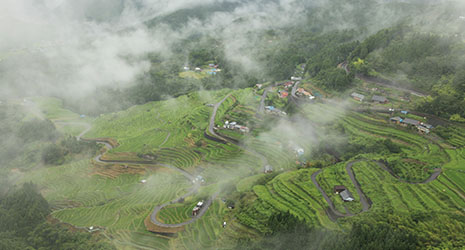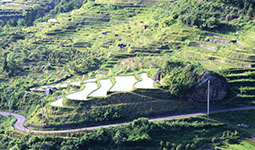Home > Highlighting JAPAN > Highlighting Japan May 2018 > Food and Agriculture Marketplace Potential
Highlighting JAPAN


Local Residents Protect Local Landscapes
Citizen-backed initiatives and local ownership are helping to preserve Japan’s many verdant rice terraces covering mountainside and ensure that they are passed on to future generations.
The largest of Japan’s rice terraces, Maruyama Senmaida, is a vast array of 1,340 rice paddies that rise up 160 meters on the southwestern slope of 736-meter-high Mount Shirakura. The Maruyama area is located in the east of Kiwa Town, part of Kumano City in Mie Prefecture. The view of large and small paddies—a proud, rich landscape reflecting the wisdom and hardships of long-ago farmers—is considered one of Japan’s finest. In 1999, the Ministry of Agriculture, Forestry and Fisheries named it as one of the 100 Best Rice Terraces in Japan.
While it is not clear exactly when these rice paddy terraces were created, according to written records there were 2,240 rice paddies here in 1601. By 1992, however, there were only about 530, the result of a policy of cedar afforestation and rice crop conversion instituted around 1970. The aging local community, depopulation and accelerating abandonment of cultivated land over the years were all factors as well.
Local residents viewed losing this precious cultural heritage during their generation as unacceptable, and were determined to preserve it. “In 1993, all the people in the Maruyama area formed the Maruyama Senmaida Preservation Society,” Kenichi Wahira of the Public Corporation to Promote Kumano City Homeland explains. “Everyone gathered to help dig up tree roots, repair the stone walls and revive the fields, which had fallen into disuse one by one. In 1994, residents joined with the local government to enact the Maruyama Senmaida Ordinance, which was the first in Japan.” Over the next four years or so, they restored 810 paddy fields covering about 2.4 hectares.
To preserve and pass on the restored paddy fields to future generations, the community established an ownership system in 1996. Owners pay an annual fee that entitles them to plant and harvest rice—done by hand in the traditional manner—and participate in mushi-okuri (using lit torches to banish harmful insects) during a traditional farming event at which everyone prays for a bountiful harvest.
“We receive over a hundred applications a year,” Wahira says. “Some owners have worked with us since we established the system over twenty years ago. Some made new friends, and there are foreigners among our owners. Each year many people look forward to planting rice together, matching their schedules.”
In recent years, students from Sagami Women’s University began visiting Kumano City as part of the region’s collaborative activities. They study the importance of agriculture and its relationship with nature while learning about rice planting, harvesting and other aspects from the locals.
“Thanks to the students, we make tremendous progress with the work,” says Kenji Yoshida of Kumano City’s Local Areas Promotion Division about the program. “The local people also look forward to interacting with their young helpers afterward. Many of the students use social media to talk about how the work is going. This is a great opportunity to tell more people about Maruyama Senmaida.”
TV and other media have picked up on the beautiful scenery and the area’s restoration initiatives, which boosts the number of tourists. But what the residents truly want is to preserve and pass on Maruyama Senmaida to future generations.
“What we are doing is not about holding fancy events and enjoying a fleeting kind of popularity,” Yoshida explains. “It’s about working with the same spirit, on an ongoing basis, as the owners and students have been doing, and increasing the number of people involved. Both the Maruyama Senmaida Preservation Society, which operates in line with the agricultural work, and the Maruyama Senmaida Protection Society, which receives financial support, have gained members each year. Seeing this cycle spreading throughout the whole country is what makes us happiest.”
Encouragement and efforts like these to protect rice terraces that can be considered the original landscapes of Japan will continue as long as the community stays strong.
© 2009 Cabinet Office, Government of Japan







